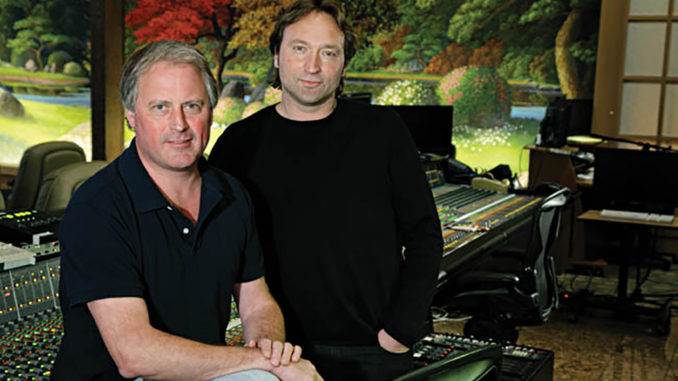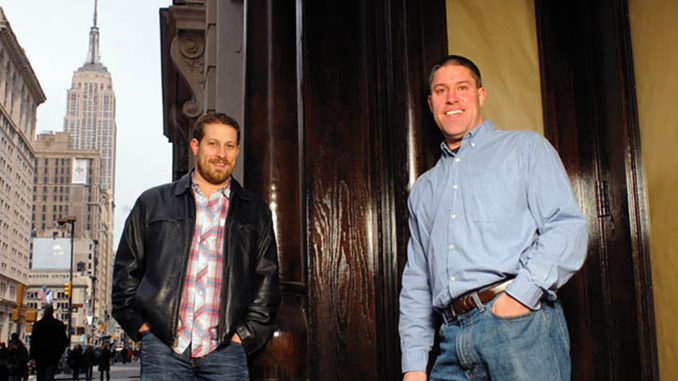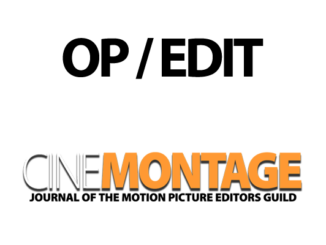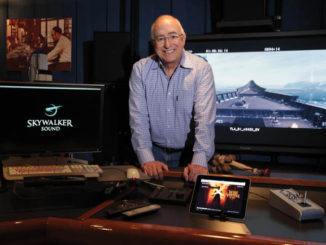
by Debra Kaufman
The re-recording mixing team is an odd phenomenon, common in Los Angeles, rare in New York and almost completely absent in Northern California. Local post-production culture, personal history and the size of the film are all factors, but one thing is for sure: Mixing teams work best when the chemistry is good, the working style is compatible and the size of the job calls for a team approach. CineMontage interviewed four mixing teams to see how they operate.
David Giammarco and Paul Massey first met in Toronto in 1998, when Massey was mixing and Giammarco was editing both sound and picture. After they both moved to Los Angeles, they found themselves working on a couple of shows together, including Boyz n the Hood (1991).
Then, four years ago, Massey was looking for another effects mixing partner to work on director Michael Apted’s Amazing Grace. The two mixed that film together, enjoyed the experience and decided to stick together as a team. “I mix the dialogue and music and Dave mixes the effects and Foley,” explains Massey. “We’ll pre-mix individually in two rooms and take responsibility for our own departments. And then we re-join for the final mix, much like any two-man mixing team.” In Sony’s Cary Grant Theatre, the two work on a Harrison MPC console, which has four sections to it; each looks after two sections.
“When we come together in the final mix and put a reel together, Paul typically will do a dialogue pass and then a music pass,” says Giammarco. “Then, I do my effects pass and preliminary balances with the dialogue and music. This makes for a good starting point to begin mixing the reel together and working with the clients.”
This style of working allows each mixer to “focus on the details of their respective departments,” says Giammarco, and then take a step back to concentrate on the overall picture. “If I were one person working alone and getting client input, he would never have a moment to stop, catch his breath and see what he’s doing,” adds Massey. “We bounce ideas off each other all the time and present something that as a team we feel confident about. The mechanics of a mix become easier when you work with all the time. We always feel free to suggest creative ideas to each other.”
Both men much prefer to work as a team than solo. Over the last three years, each of them has worked solo only once: Massey on Pirates of the Caribbean: At World’s End (2007) and Giammarco on Pineapple Express (2008).
Massey notes that the two-person mixing team is “pretty much the norm” in Los Angeles. “It used to be dialogue, music and effects as three-person teams,” he says. “That trend evolved in the mid-1990s to two-person teams.” You won’t find a solo mixer tackling a big action film from scratch to final mix; that simply isn’t in the cards. “It would not only be quite exhausting but would also take a lot more time,” he adds.

Photo by John Clifford
Sean Garnhart and Cory Melious mix the hit TV show Damages as a team but came to teamwork from different places. Garnhart started his career as a sound effects editor, a job he still does. “I have always followed a project all the way through, as opposed to handing it off to another mixer and trying to explain what the director and I have discussed for months,” he says. One of his first feature mixing credits was O Brother, Where Art Thou (2000), and he has frequently worked in teams, recently with Tony Volante at Sound Lounge.
For Melious, who began mixing at Sound Lounge almost eight years ago, working with Garnhart on Damages is his first experience working in a team. The two met when Garnhart was at the Sound Lounge working on the feature Hot Rod(2007) with Volante, and Melious did some temp mixes for the film. On Damages, Garnhart mixes dialogue, production sound and music, while Melious takes care of sound effects, Foley and backgrounds. The two work on a dual Icon stage.
Garnhart—who also has credits as sound designer as well as mixer and sound effects editor—claims that because he loves interfacing with clients, sound mixing is the role he’s most drawn to, but he loves integrating all of the roles. “When I’m hired as a supervising sound editor, my clients know they’re getting a sound designer and mixer as well,” he says. “They appreciate that common thread.”
He also prefers working as part of a team. “I’m a huge fan of working with other mixers,” he says. “Although I trust my own ears, it’s wonderful to get feedback from other people I trust. Often that feedback comes from the mixer sitting next to me.” On the other hand, Melious, who is more accustomed to working solo, says he doesn’t prefer one or the other. “It’s definitely a benefit on a bigger project to have multiple mixers,” he adds.
Teamwork can also play an important role when mixers are dealing with the tight deadlines of a television show, says Melious. On Damages, they have three days to mix a 45-minute show. “On the stage, I get the Foley from the Foley editor and, while Sean is taking a pass on dialogue, I’ll get the Foley pre-dubbed,” he says. “Then we take a pass together and do tweaks at the same time, collaborating on the sound as a whole. Since Sean is a really, really great sound designer, he gives me a lot of good suggestions on that.”
Teamwork can create not only an exchange of ideas and creativity but also knowledge. Just as Melious says he’s learned more about sound design from Garnhart, so Garnhart credits effects mixer Doug Hemphill as a mentor. Garnhart supervised editing and designed sound for Ice Age (2002) and Robots (2005), and then did pre-dubs for the movies. “Knowing that Doug was going to mix the finals was intimidating,” says Garnhart. “But his feedback was extremely supportive and priceless. He helped me become the mixer I am today.”

Photo by Gregory Schwartz
In 1993, Anna Behlmer was bouncing around from stage to stage at Todd-AO when she got a try out in mixer Andy Nelson’s room. The movie was In the Name of the Father and it was a baptism of fire. “They came in the door with this film and had two and a half weeks to complete it,” recalls Nelson. “I’d never worked with Anna, but we each spent a week pre-mixing and then jumped into the final with director Jim Sheridan. And the thing came together so quickly and so well. It was edgy, fast and just worked.”
And a new mixing team was born. The two immediately went into Greedy, then The Cowboy Way and The River Wild, all in 1994. Other notable movies that followed include Braveheart(1995), Courage Under Fire (1996), L.A. Confidential (1997) and many others.
At the time they first teamed up, Behlmer was at the beginning of her career; she had only been mixing for three years. Nelson already had 10 years as a mixer under his belt––first at the UK’s Shepperton Studios in the early 1980s working in TV, then at Film House Toronto, where he worked with Norman Jewison and David Cronenberg, and lastly at Todd-AO in 1989. Both say that their chemistry working together was evident from the first job.
“So much of it is personality,” says Nelson. “I really loved Anna’s energy coming in and her freshness. It was an immediately comfortable teaming. That’s the important thing. The familiarity with the way we work grew over time. The most important thing to start with was knowing there was good communication between us.” Behlmer agrees. “The longer you work together, the more you develop a style you share,” she says.
The work split is simple: Nelson handles dialogue and music while Behlmer handles sound effects. The two do not work together during the pre-mix but come together on the final. “It gives me a chance to be objective with the work she’s been handling and it gives her a fresh look at the music,” says Nelson. “We’ve stuck with that style.” Behlmer concurs, adding, “We know a lot of groups that pre-dub together, but we’ve never worked that way.”
That’s because they both believe that many decisions should be put off until the final mix, with the director present. “The way Andy pre-dubs, he leaves himself a lot of range to work the dialogue up until the very end,” says Behlmer. “With effects, it’s better to get things as close as possible in the pre-dub stage. But with dialogue, you have to stay more flexible.”
The final mix is that final step of interrelating dialogue, music and effects, according to Nelson. “It’s like a prep chef,” he says. “Until you mix all the ingredients, you won’t know what you’ll get.” In the final, Nelson does a dialogue pass and they do a run through the music, with Behlmer present. Then she begins putting her effects against those tracks and they create a rough shape. “Then we sit down together and do a cue-to-cue mix,” she says.
Teamwork for this pair is a matter of philosophy as well as personality. “We both believe in broad strokes,” explains Nelson. “We never work in small details from the beginning. I need to see the story and the emotional arc. What I like to do is sit back with Anna, and play the music in almost one run. It’s rough, but it immediately tells the story––what the filmmaker wants to achieve. And that opens the whole discussion for what we want to achieve.”
Although both prefer working as a team, they can’t always do so. Recently, Nelson mixed Avatar (2009), and Behlmer mixed Diary of a Wimpy Kid (2010). “It depends on the director, the schedule and the project,” says Behlmer, who estimates that they work together 85 percent of the time.
“With Parker responsible for sound effects, Foley and backgrounds, and Millan handling dialogue and music, the two work in a parallel process on separate stages, pre-dubbing their own disciplines.”
Scott Millan and David Parker were introduced to each other five years ago by Soundelux sound editorial supervisor Per Halberg, MPSE, after he worked with Parker on Van Helsing (2004). “He knows each person’s strengths and advocated for me to work with David,” explains Millan. “I had started out at Todd-AO, left for Sony Pictures and was returning to Todd-AO so there was a chance for me to explore.” Parker notes that Halberg thought the two would be compatible. Their first job as a team was on Stephen Herek’s Man of the House (2005).
“We had a good time,” recalls Parker. “We worked well together and the client liked us. It was a good fit.” Working with a new partner is like a three-legged race, according to Millan. “You have to be in sync with one another and you can quickly find out how your sensibilities jibe,” he notes. “And there’s an etiquette on a dub stage in knowing what the other one is working on, and supporting them. Working with David was immediately comfortable for me. It fit.”
The two came to this new partnership with a wealth of mix team experience–– Parker in Northern California and Millan in Hollywood. They both remember when the typical teams were made up of three people, and Millan recalls the experience of teamwork as also being a chance to be mentored. He worked with many mixers at Todd-AO, including Gary Bourgeois, Richard Portman, Chris Jenkins and Andy Nelson. “Since I got a chance to gaff the stage in the mid-1990s, I’ve worked with four different people as a routine team,” he says.
With Parker responsible for sound effects, Foley and backgrounds, and Millan handling dialogue and music, the two work in a parallel process on separate stages, pre-dubbing their own disciplines. Then they come together for the final, with the director, and combine their own disciplines. “It’s a creative process and a collaborative process,” explains Millan, who mentions that they work on a Euphonix System 5 console. “You never know what will spawn a direction or concept that could make the difference,” he continues. “You have a chance to work off each other, and it’s a huge advantage. There’s an organic factor to having someone you’re working with who has his own perspective. Playing back and forth, it’s like two musicians.” Millan also points out the importance of crews, including stage techs; he works most frequently with Drew Webster.
“You can inspire and help each other too,” adds Parker. Both of them say the team approach is a necessity with today’s schedules. “The shows are larger and larger,” says Parker. “The more hands the better.”
“It would be impossible for the most part to do this as a solo mixer,” says Millan. “As it stands now, David and I have worked on projects where we don’t go home for three days. One person couldn’t physically do it all.” They even occasionally work on smaller films together, such as Taylor Hackford’s Love Ranch (2010). “We jumped on that and maximized the resources,” says Millan. “He’s a loyal client and someone we want to work with as much as we can, so we do the work as smart and cost-effectively as possible.”
Although they work together 80 to 85 percent of the time, they aren’t working together at the moment: Parker jumped on to Iron Man 2 to help finish that project, and Millan is at work on Oliver Stone’s Wall Street: Money Never Sleeps. But mixing as a team is always their first choice. “These partnerships are marriages of a sort,” states Millan. “One of the biggest facets of a good partnership is mutual respect––and not just for the other person’s abilities but for the person himself.”






